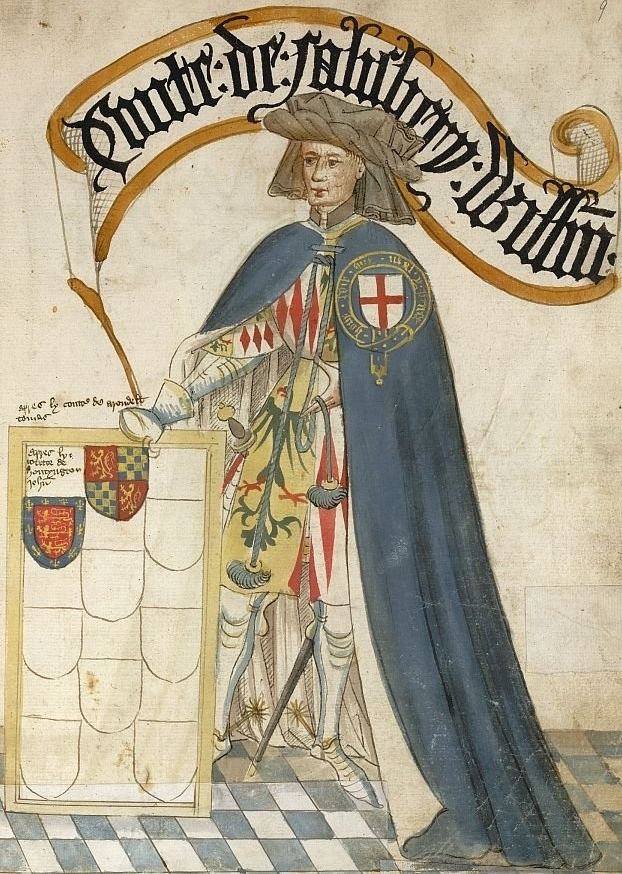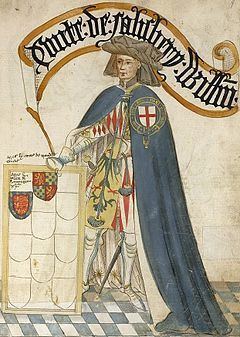Mother Catherine Grandison Died June 3, 1397 | Name William Montacute, | |
 | ||
Reign 30 January 1344 – 3 June 1397 Born 25 June 1328
Donyatt, Somerset, England ( 1328-06-25 ) Father William Montacute, 1st Earl of Salisbury Spouse Elizabeth de Mohun, Joan of Kent Parents William Montagu, 1st Earl of Salisbury, Catherine Montagu, Countess of Salisbury Siblings John de Montacute, 1st Baron Montacute Grandparents William Montagu, 2nd Baron Montagu Similar People Joan of Kent, Richard II of England, Margaret Pole - Countess, Edward - the Black Prince | ||
William de montacute 2nd earl of salisbury
Sir William de Montagu, 2nd Earl of Salisbury, 4th Baron Montagu, King of Mann, KG (25 June 1328 – 3 June 1397) was an English nobleman and commander in the English army during King Edward III's French campaigns in the Hundred Years War. He was one of the Founder Knights of the Order of the Garter.
Contents
- William de montacute 2nd earl of salisbury
- William de montagu 2nd earl of salisbury
- Biography
- First marriage
- Military career
- Second marriage
- References
William de montagu 2nd earl of salisbury
Biography

Lord Salisbury was born in Donyatt in Somerset, the eldest son of William Montagu, 1st Earl of Salisbury and his wife Catherine Grandison. One of his sisters, Philippa (d. 5 January 1382) was the wife of Roger Mortimer, 2nd Earl of March. Lord Salisbury succeeded his father as earl in 1344. In 1348, Lord Salisbury, at this time married to the King's first cousin, was one of the knights admitted at the foundation of the Order of the Garter.
First marriage
In the early 1340s, Lord Salisbury was married to Joan of Kent, a first cousin of the King, and a princess of England. Both Lord Salisbury and his bride were of exactly the same age, and both were in their early teens. Lord Salisbury entered into the marriage in good faith, without knowing that Joan had already, at the age of twelve, secretly married Thomas Holland, just before the latter left England on crusade. Upon returning to England in 1348, Holland declared that Joan was his wife and demanded that she be restored to him. An inquiry was instituted to examine the question, and it found that Joan had indeed been married to Holland, and that that marriage was valid in law; consequently, Lord Salisbury's own marriage to Joan was invalid. During the proceedings of the inquiry, Lord Salisbury was dismayed and chagrined to find that Joan herself was in favor of her marriage to Holland being upheld, and her marriage to Lord Salisbury voided. Following the findings of the inquiry, and after several years of living together with her, Lord Salisbury's marriage with Joan, Fair Maid of Kent, was annulled by the Pope in 1349.
Military career
Lord Salisbury, by now twenty-one years of age, was showing signs of becoming a successful military commander. Despite the fiasco of his marriage with a member of the royal family, Lord Salisbury rose rapidly in the ranks of the army upon the strength of his own competence. He served as a commander of the English forces in France in many of the following years, including as commander of the rear guard of Edward the Black Prince's army in 1355, and again at the Battle of Poitiers in 1356, and further serving in 1357, 1359 and 1360. Later in 1360, he was one of the commissioners who negotiated the Treaty of Brétigny.
During the quieter years that followed the treaty, Lord Salisbury served on the king's council, working closely with King Edward III. He returned to the field in 1369, serving in John of Gaunt's expedition to northern France, and then in other raids and expeditions, and on some commissions that attempted to negotiate truces with the French. Lord Salisbury helped Richard II put down the rebellion of Wat Tyler. In 1385, he accompanied Richard II on his Scottish expedition.
In 1392/3, Lord Salisbury sold the Lordship of the Isle of Man to William le Scrope of Bolton.
Second marriage
Lord Salisbury married Elizabeth, daughter of John de Mohun, 9th Lord de Mohun of Dunster. They had a son and two daughters and lived at Bisham Manor in Berkshire. Their only son, Sir William Salisbury married Lady Elizabeth FitzAlan, daughter of Richard Fitzalan, 11th Earl of Arundel, but was killed in a tournament in 1383, leaving no children. Therefore, when Lord Salisbury died in 1397, the earldom was inherited by his nephew, John Montagu, 3rd Earl of Salisbury.
